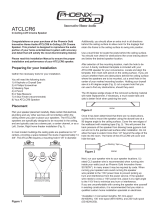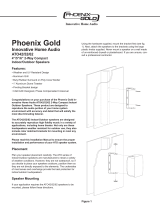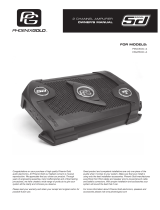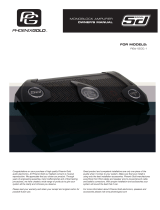Page is loading ...

AS8SW
8” In-Wall Subwoofer
Congratulations on your purchase of the AudioSource
AS8SW In-Wall Subwoofer. This product is designed
to reproduce the Low Frequency audio portion of your
home entertainment system with accuracy and detail
that will satisfy the most discriminating listener.
Please read this Installation Manual to ensure the proper
installation and performance of your AS8SW speaker.
Preparing for your Installation
Gather the necessary tools for your installation.
You will need the following tools:
1) A Keyhole or Drywall Saw
2) A Phillips Screwdriver
3) Masking Tape
4) A Pencil
5) A Bubble or Laser Level
6) A Tape Measure
7) A Stud Finder (recommended)
8) Your AS8SW Speaker
Placement
Plan your speaker placement carefully. Make certain that
electrical, plumbing and any other services will not interfere
within the walls where you plan to place your speakers. The
AS8SW speakers can be mounted in the walls or in the ceil-
ing, but are typically used in walls. The speakers should be
located so that they provide even coverage at your listening
position. The distance between the speakers should not be
greater than the distance from the speakers to the listening
position.
(see fi g. 1)
Existing Construction
In most modern buildings the wall studs are positioned on
16” centers, providing a space between the studs of approxi-
mately 14 3/8”. The AS8SW requires a mounting hole 8 3/4”
wide and 8 3/4” high. Additionally, you should allow an extra
inch in all directions behind the wall surface to allow room for
the doglegs that retain the frame to the wall surface to swing
into position.
AS8SW
Use a stud fi nder to locate the vertical studs be-
hind the wall surface. You should now check for
obstructions like cross bracing above and below
the desired speaker location.
After selection of the mounting location, mark the
hole to be cut out. A template is provided in the
speaker box. Locate and level the template, then
mark with pencil on the wall surface. If you are
unsure whether there are obstructions behind the
wall surface where the speakers are to be mount-
ed, cut a small hole in the center of your marked
mounting location. Holding your drywall saw at
a 45 degree angle (see Fig. 2) cut a square hole
that you can use to fi nd any obstructions, should
they exist.

Once it has been determined that there are no obstructions,
cut the hole to mount the speaker using the drywall saw at
a 90 degree angle to the wall surface. Cover the raw edges
of the wallboard with masking tape (see Fig. 3). This will
prevent the back pressure of the speaker from blowing loose
gypsum dust out and on to the painted wall surface after
installation. Do not allow the tape to extend more than 1/2”
beyond the edge of the hole into the room. The frame of the
AS8SW will cover and hide the tape.
Next, run your speaker wire to your speaker locations. A UL
rated, CL3 speaker wire, is recommended when running
wire inside your walls (such as Phoenix Gold Innovative
Home SS162W*). In many areas it may be required by code.
When running your speaker wire you should avoid having
the speaker wire run parallel to the 110V power lines to avoid
picking up hum and interference from the power service.
If the speaker wire needs to cross a 110V power line do it
at a right angle, this is acceptable and should not create a
problem.
If you are uncomfortable with running the speaker wire
yourself in existing construction, it is recommended that
you retain a qualifi ed custom home installation specialist or
electrician.
*Available in 3 convenient lengths: 50’ mini-spool
(M1650W), 100’ mini-spool (M16100W), and 250’ bulk spool
(SS162W/250).
Installing the Subwoofer
Installation Tip!
To further enhance the performance of your
AS8SW speakers, the wall stud cavity where you plan to
place your speakers can be stuffed with a generous quantity
of fi berglass insulation. If uninsulated, stuff the area above
and under the speaker opening with 6” thick insulation to a
depth of approximately 2 feet beginning 1 foot above and
1 foot below the speaker opening. If the insulation is foil
or paper backed, face the backing away from the AS8SW
speaker. The addition of this insulation will help prevent the
unwanted transfer of sound into the large and resonant cav-
ity of the uninsulated wall.
It is now time to connect the speaker wire to
the AS8SW. Your speaker wire is usually cod-
ed to maintain proper system phasing. This
can be by color coding, or one conductor may
have a printed marking or at least a rib along
one edge that will not be found on the other.
Identify which type of polarity coding that your
wire is using. You must carefully observe that
the positive terminal of the speaker output
on your amplifi er is connected to the positive
terminal of the AS8SW speaker. Likewise, the
negative terminal of the amplifi er’s speaker
output should be connected to the negative
terminal of the AS8SW speaker (Fig. 4).
Next, make sure that the doglegs are positioned
inside the frame of the speaker (Fig. 5).
With the grill removed, place the speaker in the
wall opening. Make sure that the speaker wire
is not hanging against the speaker where it can
vibrate and rattle as the speaker reproduces your
music.
Next, one at a time, turn each of the four screws
(Fig. 6) that operate the doglegs counter clockwise
a few turns until you feel the dogleg is loose from
its resting position. Now turn the screw clockwise
until you feel the dogleg contact the wall surface.
Tighten all four of the mounting
screws in the same manner
until the speaker is properly
aligned and held securley to the
wall surface.
Caution: Do not over tighten!

Painting the Speaker
A paint shield is included in the AS8SW speaker package.
A paint shield is included in the AS8SW speaker package.
Place the paint shield inside the frame to protect the speak-
Place the paint shield inside the frame to protect the speak-
er. You can now safely paint the speaker frame to match
er. You can now safely paint the speaker frame to match
your wall surface if you desire.
your wall surface if you desire.
When painting the grill caution should be taken to ensure
When painting the grill caution should be taken to ensure
that paint does not clog or block the perforated openings in
that paint does not clog or block the perforated openings in
the grill. This would prevent full operation from the speaker.
the grill. This would prevent full operation from the speaker.
Removing the AS8SW Subwoofer
Removing the AS8SW Subwoofer
Should it ever become necessary to remove the AS8SW
Should it ever become necessary to remove the AS8SW
speaker from the wall, simply remove the grill and turn the
speaker from the wall, simply remove the grill and turn the
four mounting screws counter-clockwise until the doglegs
four mounting screws counter-clockwise until the doglegs
lock out of position in their resting seat.
lock out of position in their resting seat.
Recommended Speaker Wire Gauges
Recommended Speaker Wire Gauges
The resistance of the speaker wire in your installation can
The resistance of the speaker wire in your installation can
cause your subwoofer to perform at less than an optimum
cause your subwoofer to perform at less than an optimum
quality level. Excess resistance, caused by using an under-
quality level. Excess resistance, caused by using an under-
sized speaker wire, can result in loss of detail and defi nition
sized speaker wire, can result in loss of detail and defi nition
in the low frequency region of your audio program, as well as
in the low frequency region of your audio program, as well as
a loss of dynamic range.
a loss of dynamic range.
To prevent this effect in your installation, we have recom-
To prevent this effect in your installation, we have recom-
mended speaker wire gauges that should not exceed 0.5
mended speaker wire gauges that should not exceed 0.5
Ohms resistance over the recommended length of wire run.
Ohms resistance over the recommended length of wire run.
For the AS8SW subwoofer, we suggest the following mini-
For the AS8SW subwoofer, we suggest the following mini-
mum speaker wire gauge be used:
mum speaker wire gauge be used:
50’ or less – 16 Gauge 2-Cond. CL3
50’ or less – 16 Gauge 2-Cond. CL3
50’ – 150’ – 12 Gauge 2-Cond. CL3
50’ – 150’ – 12 Gauge 2-Cond. CL3
150’ – 200’ – 10 Gauge 2-Cond. CL3
150’ – 200’ – 10 Gauge 2-Cond. CL3

AS8SW Specifi cations
Woofer 8” Carbon Poly Cone with Butyl Surround
Frequency Response 40 Hz to 200 Hz
Impedance 8 Ohm
Recommended Amp Power 25 to 125 Watts Continuous
Cut Out Dimension 8 3/4” x 8 3/4” (22.2cm X 22.2cm)
Two Year Limited Warranty
AudioSource, a division of Rodin, warrants this product against defects in materials and workmanship for
a limited period of time. For a period of two (2) years from date of original purchase, we will repair or replace the
product, at our option, without charge for parts. Customer must pay for all labor charges associated with the re-
moval and re-installation of speakers for the limited period and all parts and labor charges after the limited warran-
ty period expires. The limited warranty period for factory refurbished products expires after ninety (90) days from
date of original purchase. This limited warranty applies only to purchases from authorized AudioSource Retailers
or Distributors. This limited warranty is extended only to the original purchaser and is valid only to consumers in
the United States.
Consumers are required to provide a copy of the original sales invoice from an authorized AudioSource
Retailer, or Distributor, when making a claim against this limited warranty. This limited warranty only
covers failures due to defects in materials or workmanship that occur during normal use. It does not cover failures
resulting from accident, fi re, fl ood, misuse, neglect, mis-handling, mis-application, alteration, faulty installation,
modifi cation, service by anyone other than AudioSource, or damage that is attributable to Acts of God. It does
not cover costs of transportation to AudioSource or damage in transit. The customer should return their defective
product, freight prepaid and insured, to AudioSource only after receiving a Return Authorization.
Repair or replacement under terms of this warranty does not extend the term of this warranty. Should a product
prove to be defective in workmanship or material, the consumer’s sole remedies will be repair or replacement as
provided under the terms of this warranty. If the defective product is discontinued AudioSource may replace the
product with an equivalent or superior product at its option. Any cost of re-installation or repair of wall or ceiling
surface is the sole responsibility of the customer and that cost shall not be the responsibility of AudioSource. Un-
der no circumstances shall AudioSource be liable for loss or damage, direct, consequential or incidental, arising
out of the use of or inability to use the product. There are no express warranties other than described above.
Rodin 9200 North Decatur Street Portland, Oregon 97203
Tel: 503.286.9300 Fax: 503.978.3381 Tech Support: 800.950.1449
Web: www.AudioSource.net Email: [email protected]
8100.0339A
/







